Pipistrello and the Cursed Yoyo is a top-down action and adventure videogame aesthetically inspired by popular handheld videogames of the early 2000s; essentially, it casts itself as a rediscovered classic Game Boy Advance adventure. I play as Pippit, the disappointing outcast of the powerful Pipistrello family who uses his access to the family fortune to embark on childish, yoyo-based adventures. He returns to the family’s electric power plant in New Jolt City just in time to witness his aunt, the ruthless company owner Madame Pipistrello, be attacked by four rival business leaders. As they try to drain Madame Pipistrello’s soul into four Mega-Batteries, Pippit interrupts with the only tool at his disposal: his yoyo. The intervention transfers part of Madame Pipistrello’s soul onto Pippit’s yoyo, imbuing it with her personality and a fraction of her awesome power. Guided by the irascible voice of his cursed aunt and using the strange powers of his magically enhanced yoyo, Pippit sets out into New Jolt City to defeat the Pipistrello family’s rivals, reclaim the four Mega-Batteries, and restore his aunt to her rightful form.
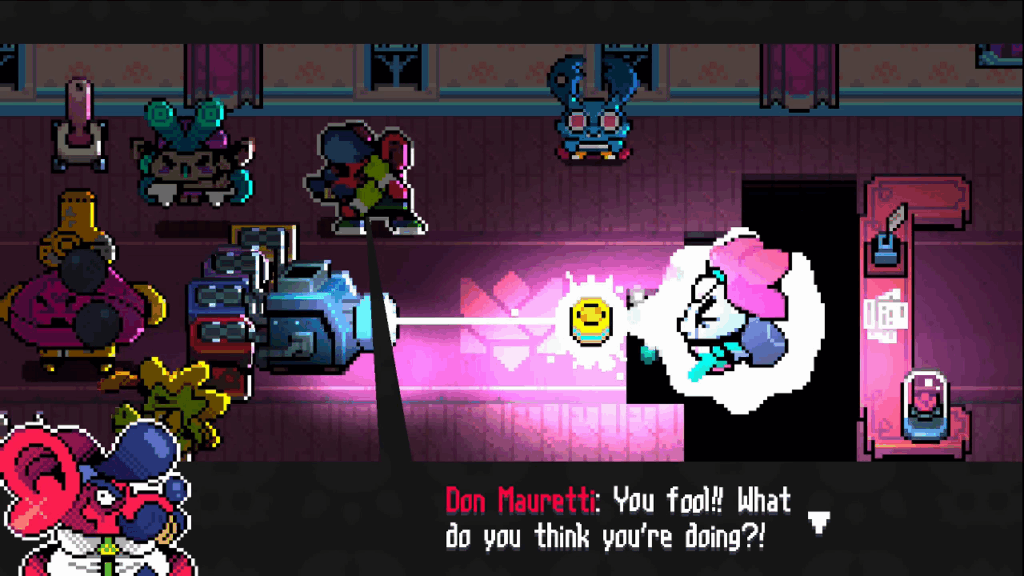
Pipistrello and the Cursed Yoyo presents itself as a videogame played on a handheld platform that exists inside my screen: The Pocket Trap Game System. The first time I boot up the videogame, I am introduced to this fictional handheld before I even see a title screen. If the Pocket Trap Game System was real, it might have been an exciting piece of technology in its heyday. A widescreen display sits between two angular grips. It has four face buttons and two shoulder buttons. More intriguing is the four triggers found on the backside of the unit.
I’m not sure this fantastic device would be comfortable to hold. When I imagine manipulating the shoulder buttons and all four rear triggers simultaneously, my fingers become confused and my grip on the handheld’s edges grows tenuous. As I play more of Pipistrello and the Cursed Yoyo, I find it is designed to be played with a standard gamepad with all the features common to every contemporary platform. All those extra buttons on the fictional console seem decorative. They do not matter. This handheld does not exist.
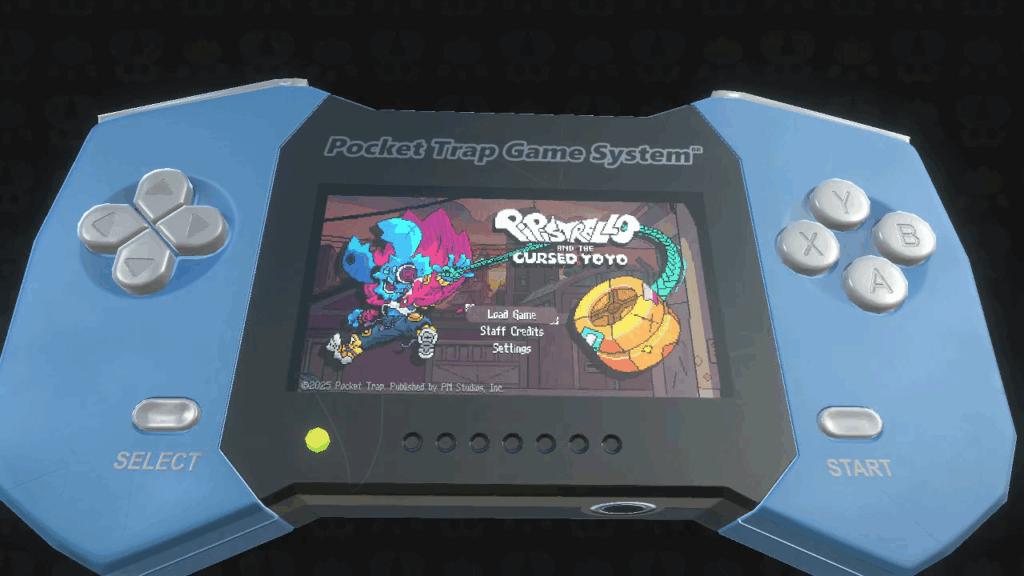
The real purpose of the Pocket Trap Game System is to evoke a graphical style from a specific era of handheld videogames. Individual pixels are numerous and visible, though their effect is softened by density and variety. The “screen” can display thousands of pixels at once in hundreds of different colors. Pipistrello and the Cursed Yoyo uses these features to embody the vibrant and rounded techniques of 2000s-era pixel art and animation.
The final touch the Pocket Trap Game System brings to the visuals are filters. A familiar LCD screen filter is present, common to contemporary pixel art videogames, overlaying a grid over the image that buffs and shears the ragged edges of pixelated lines as though I am viewing them through an older display. A more interesting inclusion is a 3D Console filter. This overlays a glossy effect over the image, as though I am viewing it through a glass screen illuminated by an external light source, as was the common way to play handhelds before backlit screens became standard.
I consistently feel retro screen filters that attempt to mimic the visuals of older screen technology are distracting and artificial. I leave them turned off whenever possible. I appreciate how Pipistrello and the Cursed Yoyo’s filters place its graphics in a specific videogame era, though that appreciation does not budge my impression that it is a worse way to play. The filters are included to enhance the verisimilitude of playing a videogame on a turn-of-the-century handheld, not to actually make the videogame look better. These thematic embellishments are ultimately easy to ignore. Unless I turn on the 3D Console filter, the Pocket Trap Game System becomes invisible once I leave the main menu.
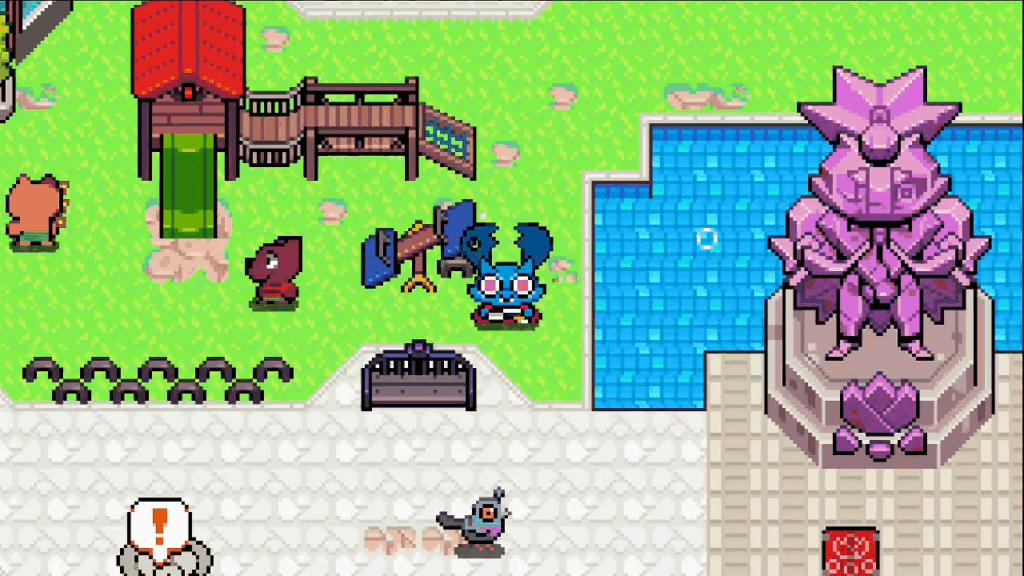
Looking at player character Pippit’s design, particularly his dynamic pose on the title screen, it’s not clear to me what kind of creature he is supposed to be. Multiple lines of dialog identify him as a bat. His huge ears have multiple jagged spikes on their inside edges, making them resemble a crude claw emerging from his scalp more than tools evolved for echo location. If Pippit has improved hearing compared to other animals, nothing in his toolkit suggests it. His wings, if they even exist, are hidden inside his jacket’s sleeves and never used for gliding. His identity as a bat doesn’t factor into his design. The choice feels arbitrary, even superfluous. He could be any other kind of creature and it wouldn’t change the videogame at all.
Far more important than the player character’s physical characteristics is the distinctive tool he carries with him from the start of his adventure. Pippit’s magically enhanced yoyo is how he interacts with almost everything in New Jolt City. It is the weapon he uses to defend himself from the cronies, thugs, and goons employed by the Pipistrello family’s business rivals. At the outset, it functions as a simple projectile, stretching its spinning cylinder to the limits of its string then retracting back into its owner’s hand.
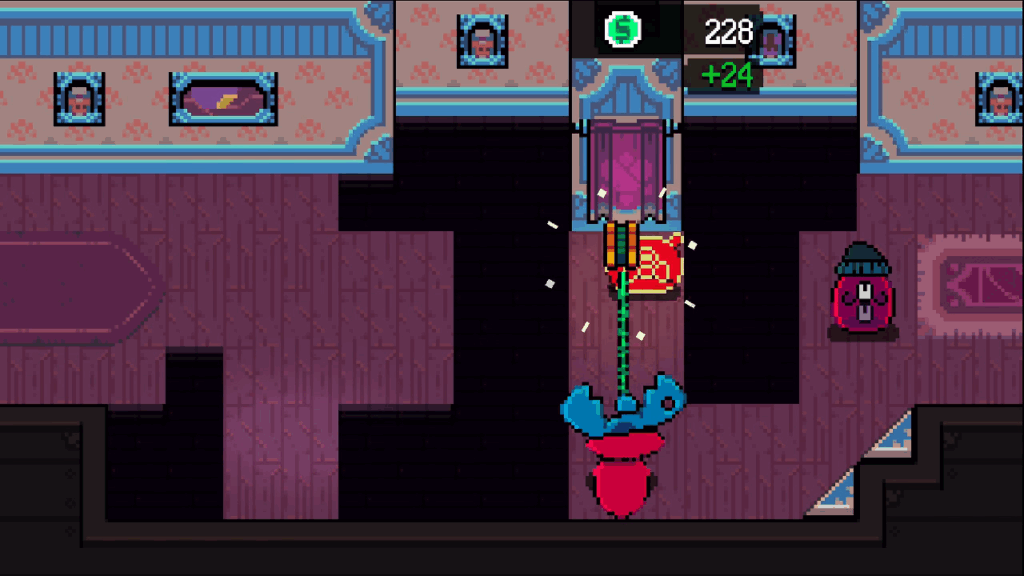
Pippit adds new yoyo techniques to his repertoire as he explores New Jolt City’s four sections. With the Sleeper technique, he can leave the yoyo spinning at its maximum length for as long as I hold a button, trapping any foe caught beneath it in continuous damage. Around the World flings the yoyo in a fast circle around Pippit, damaging and pushing away any enemies caught in its path; this is especially useful because foes are not shy about attacking in mobs of ten or more. Just when the yoyo’s limited range begins to feel like a detriment, Pippit learns Offstring Throw that lets him hurl the yoyo across the entire screen as a damaging projectile. This must be used judiciously as it leaves Pippit with only a weak string to defend himself until he can reattach it to the yoyo.
Pippit’s yoyo attacks come in two categories, Charge and Special, and he can only equip one of each at a time. He may further specialize his loadout by equipping Badges he finds and earns around New Jolt City. Many are mundane improvements like flat damage increases that are useful in all situations. Other Badges require a little more strategic application. At first, the Offstring Throw’s downsides feel daunting, discouraging its use in combat outside specific scenarios. Equipping Badges that improve the attack and stunning power of the string and turn the disconnected yoyo into an automated turret can make the Offstring Throw a more appealing option. These are far from the only alternate strategies new Badges make available to Pippit.
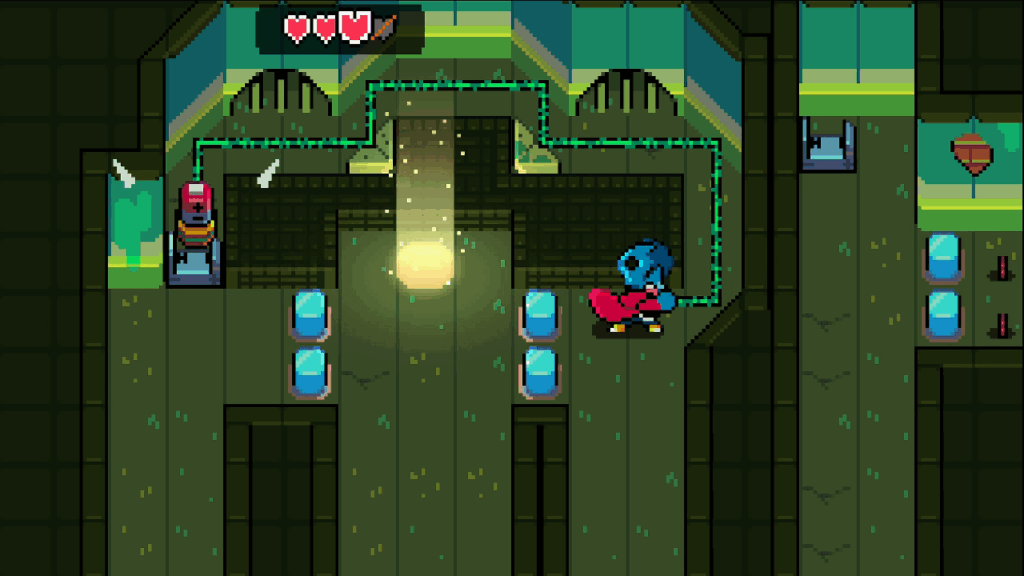
As often as Pippit uses the yoyo to defend himself, he uses it to explore New Jolt City. Almost every screen contains at least one obstacle Pippit must use his yoyo to overcome. Obstacles have straightforward beginnings, like using the yoyo to activate a switch on the other side of a pit. Subsequent puzzles add complexity; the yoyo still activates a switch, but now it rebounds between multiple angled surfaces, its string magically lengthening with every corner it takes. This concept is refined further when Pippit discovers he can use Offstring Throw to carry a key or battery across otherwise impassable obstacles. In many rooms, the puzzle is finding the way to get both Pippit and an item carried by his yoyo safely across the room. Their ingenuity is equaled by the skill and experimentation required to solve them.
Almost as soon as his story begins, Pippit encounters pits and pools of water around New Jolt City that are impassable with his rudimentary jumping abilities. It takes new yoyo tricks to move past these obstacles, and once again the imagination put into their application is impressive. Familiar yoyo tricks like walking the dog and UFO are magically exaggerated to carry Pippit across obstacles. Walking the dog imbues the yoyo with the power of an engine that pulls Pippit behind it at high speed, even across bodies of water. UFO transforms the yoyo into a floating target Pippit can target with the string like a grappling hook, carrying him across many wide gaps. Pippit learns four movement tricks in total and by the final steps of his adventure he must navigate long obstacle courses that demand all four tricks be used in succession with perfect timing and execution.
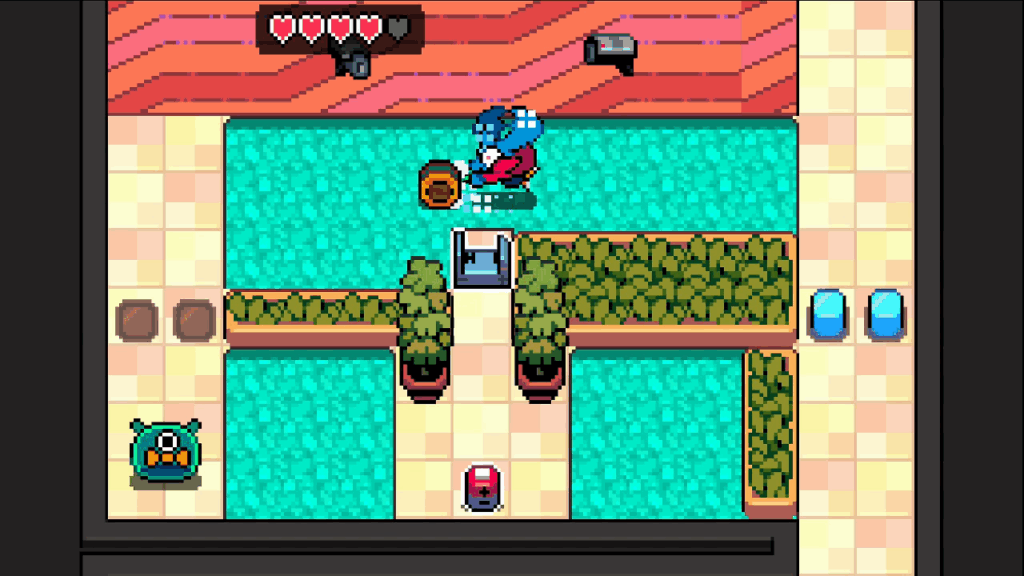
New Jolt City is divided into four roughly equal regions controlled by one of the Pipistrello family’s business rivals. Each uses their Mega-Battery imbued with some of Madame Pipistrello’s essence to enact a shady and super-powered business plan. The Slime Tycoon uses the construction of his tower headquarters as a cover to excavate the ground underneath for riches, filling his region of New Jolt City with earthquakes and sinkholes. Don Mauretti pumps out addictive and unhealthy fast food from his factory’s conveyor belts. Toxy is in charge of a Coachella-style festival in the city park. Carrara operates a sports stadium with robotic players.
The specific details of these shady businesses reveal Pipistrello and the Cursed Yoyo’s social conscience. The Slime Tycoon’s disregard for the damage his excavations cause to New Jolt City recalls the environmental damage created by our world’s largest industries. Don Mauretti purposefully tries to make his food more addictive and drive his competition out of business without concern for his customers’ health. Toxy and Carrara’s businesses seem harmless until I pay closer attention to the services they offer. A kiosk at the entrance to Toxy’s festival tries to sell Pippit cryptocurrency and speculative digital real estate; their title is even listed as Exploitative Marketing Strategist & Advocate for Sedentary Technology, a fancy way of saying they push get-rich-quick scams. Carrara’s stadium forces gambling opportunities on its attendees at every opportunity, echoing the gambling apps that have a chokehold on college and professional sports broadcasts in our world. Without putting it in so many words, Pipistrello and the Cursed Yoyo makes a deliberate statement about these business practices by putting them in the control of the narrative’s unscrupulous villains.
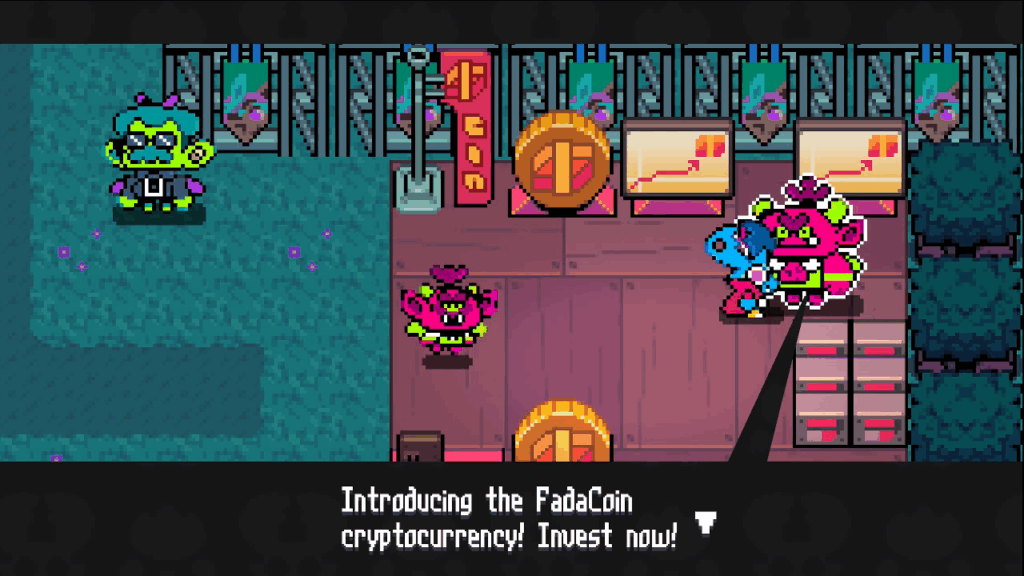
Pipistrello and the Cursed Yoyo cleverly exploit these antagonists to create traditional videogame dungeons that fit in with New Jolt City’s contemporary urban environment. A rocky cave filled with pits is justified by Slime Tycoon’s reckless underground digging. Don Mauretti’s factory and Carrara’s stadium transform familiar blue collar settings into dangerous strongholds. Toxy’s festival is the most interesting reimagining. Before Pippit can even get inside, he must find tickets to the event. This task is complicated by the line that stretches for blocks away from the park, snaking back and forth across multiple streets, creating an unexpected wall Pippit must find creative ways to bypass during his search for tickets.
While the four villains’ lairs are interesting, New Jolt City itself suffers from repetitive design. Nominally divided into five districts connected by a central hub, the only elements that really differentiate them are colors. Exploring the overworld immediately feels like wandering across the same city block over and over again. The feeling of sameness is unhelped by New Jolt City’s extensive sewer system being a prominent part of navigating every region. Wherever Pippit goes, I know he will inevitably be pulled beneath the city’s streets to bypass obstacles found above. None of these areas are poorly designed but by the time Pippit has defeated two of his Aunt’s rivals, I find myself hoping to see something in the next area besides a city street and a spacious sewer. My hopes are squandered.
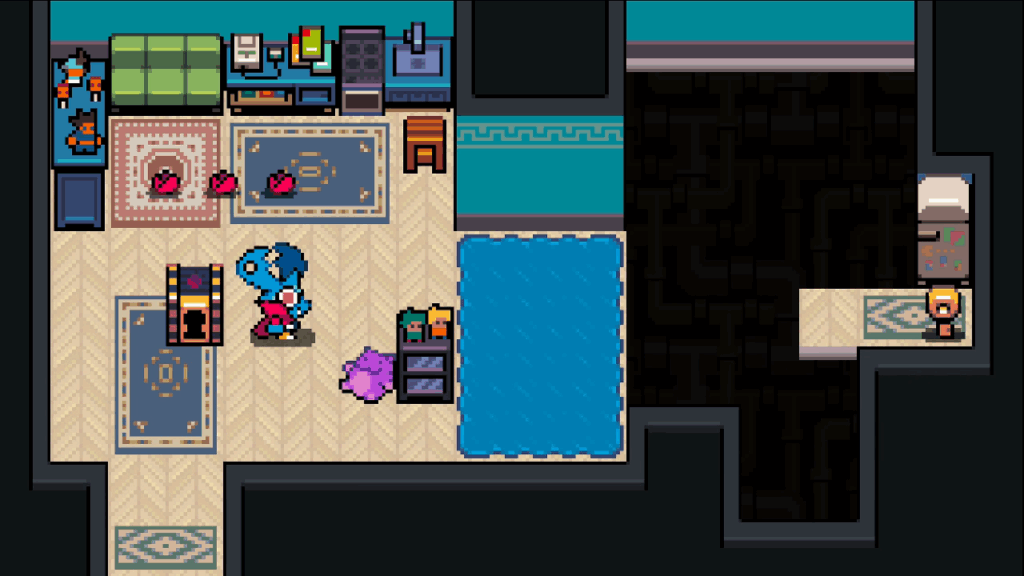
Thoroughly exploring New Jolt City is essential for Pippit’s success. Aside from new yoyo abilities, Badges, and the paths to his enemies’ hideouts, the city’s nooks and crannies hide collectables that improve his capabilities. Red Petal Containers increase his total health, raising the amount of damage he can take before dying. Green BP Shards increase his Badge point total, allowing him to equip more Badges. All these collectables are hidden inside New Jolt City’s many sewers and miscellaneous buildings. Even buildings like a museum and a movie theater are repurposed as obstacle courses filled with devious puzzles that reward these powerups. It takes a thorough eye to find them all, though the map helpfully marks any locations whose secrets have been fully uncovered with a green checkmark, preventing me from wasting time retracing Pippit’s steps.
The other important element in New Jolt City is money. Pippit uncovers dozens of chests containing coins while he explores, and every enemy he defeats explodes in a shower of currency, ensuring he is constantly filling his pockets with money. Almost nothing in the city is free. Competing in target minigames and a local biker gang’s underground arena both require an entry fee. A repeated sidequest has a random townie ask Pippit to deliver them a burger; he not only has to carry the burger all the way from the only burger restaurant in the town’s center, he has to pay for it with his own money. Even unlocking and then using the taxi-based fast travel points takes money from Pippit’s coffers.
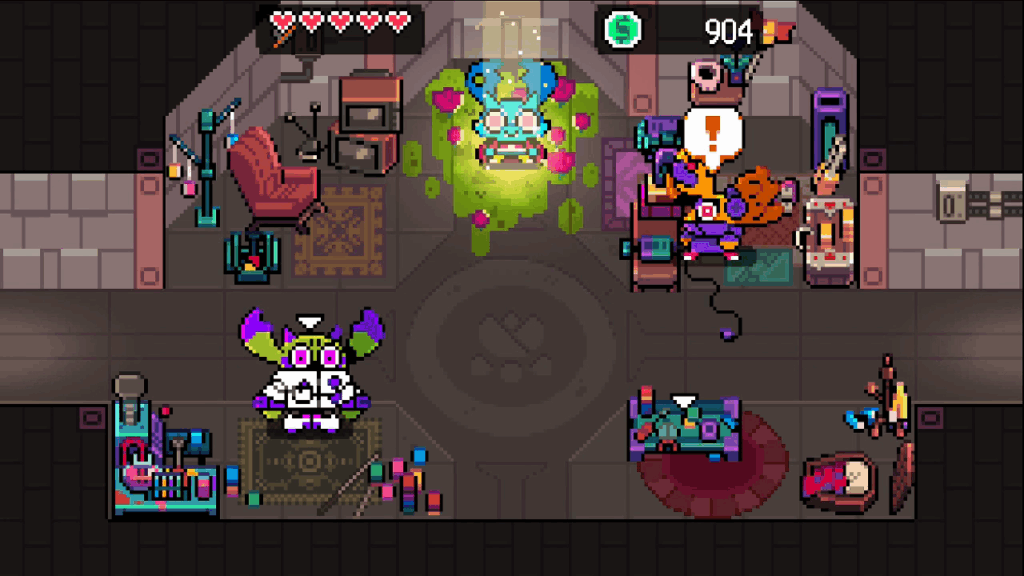
No service in New Jolt City is a greater drain on Pippit’s wallet than his cousins, Pippo and Pepita. He meets these enterprising members of the Pipistrello family early in his adventure who move into hiding in the family’s subterranean hideout. Pippo is a conventional NPC artisan, taking money from Pippit in exchange for crafting new Badges and upgrading existing ones. Pepita is the more unusual of the pair. She invites Pippit to accept contracts that improve his statistics.
Pepita’s contracts are Pipistrello and the Cursed Yoyo’s most interesting idea. Fulfilling the terms of a contract confers permanent benefits to Pipit, like longer mercy invincibility or dealing increased damage each time he picks up money. In order to gain these benefits, must explore New Jolt City for a short time with a disadvantage, like lowered attack power, and with half of all money he collects going towards paying off the contract. The greater the benefit he tries to earn, the greater the temporary deficit and the more money he must earn to work it off. The awesome power provided by completed contracts makes pursuing them worth it. If Pippit ignores these contracts to avoid a temporary loss in power in the middle parts of his adventure, he might find its conclusion much more difficult to surmount.
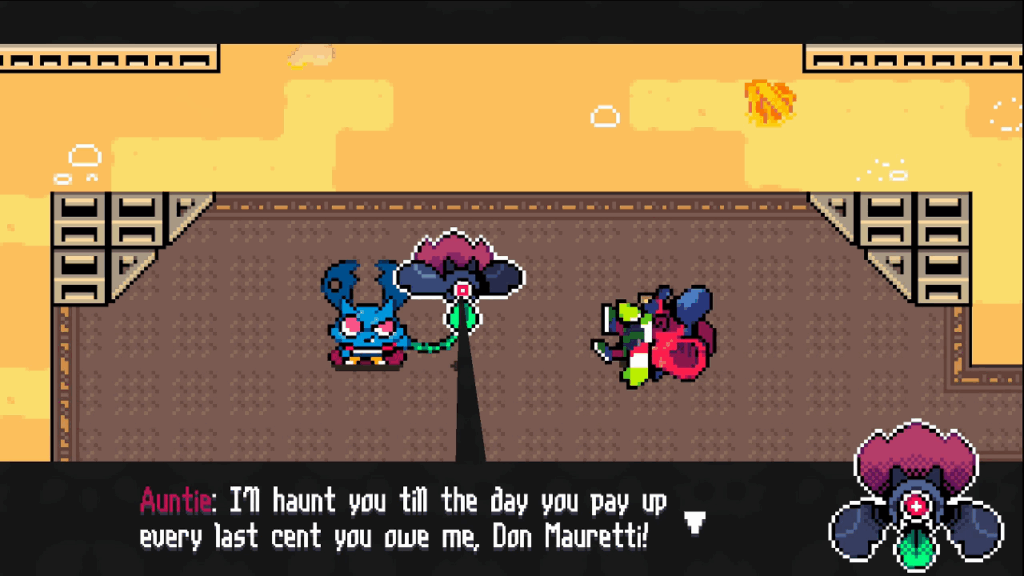
Pipistrello and the Cursed Yoyo lays out many ambitious goals for itself and excels at nearly all of them. It effectively slots itself into an iconic and nostalgic graphical niche. If somebody told me this was their favorite Game Boy Advance videogame that I had never heard of, I might believe them. Pippit’s yoyo is a wonderful item both for fighting his enemies and for traversing New Jolt City. Combat is at first rudimentary, but once Pippit gathers a collection of Badges and the Points to equip them, many interesting strategies become available. It’s even better as a puzzle solving tool, filling the environment with interesting, thoughtful, and challenging puzzles that require experimentation and creative approaches to solve. The Pipistrello family’s business rivals, while shallow, keep me engaged with the conflict while Pippit pushes towards the conclusion of his story. Only New Jolt City itself is a letdown, feeling too much like the same few city blocks repeated over and over. This is only a visual complaint, not a mechanical one, as the streets are filled with some of the best traversal options I’ve encountered this year. Pipistrello and the Cursed Yoyo feels destined to be one of 2025’s highlights.